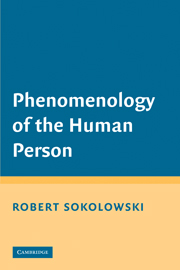Book contents
- Frontmatter
- Contents
- Acknowledgments
- Phenomenology of the Human Person
- Introduction
- PART I THE FORM OF THINKING
- PART II THE CONTENT OF THINKING
- 7 The Content of What Is Said
- 8 Properties and Accidents Reveal What Things Are
- 9 Knowing Things in Their Absence
- 10 Mental Representations
- 11 What Is a Concept and How Do We Focus on It?
- PART III THE BODY AND HUMAN ACTION
- PART IV ANCIENTS AND MODERNS
- 19 Conclusion, with Henry James
- Bibliography
- Index
8 - Properties and Accidents Reveal What Things Are
Published online by Cambridge University Press: 05 June 2012
- Frontmatter
- Contents
- Acknowledgments
- Phenomenology of the Human Person
- Introduction
- PART I THE FORM OF THINKING
- PART II THE CONTENT OF THINKING
- 7 The Content of What Is Said
- 8 Properties and Accidents Reveal What Things Are
- 9 Knowing Things in Their Absence
- 10 Mental Representations
- 11 What Is a Concept and How Do We Focus on It?
- PART III THE BODY AND HUMAN ACTION
- PART IV ANCIENTS AND MODERNS
- 19 Conclusion, with Henry James
- Bibliography
- Index
Summary
We turn back to the distinction between accidentals and essentials, and more specifically to the distinctions among accidentals, properties, and essences. We have seen that the essentials of things must be distinguished into their properties and their essences, and both of these must be differentiated from the accidentals that occur to things and are predicated about them. More needs to be said about these three dimensions of speech and the interactions among them.
Step One: Predicating Accidentals
All three of these components – the accidentals, the properties, and the essences – can be predicated of things, but they are predicated of them in different ways. For that reason, they have classically been called the “predicables.” Thus, we might say to someone, “Susan was smiling when she entered the room.” In this case, we predicate “smiling when she entered the room” accidentally of Susan. Susan was smiling at that moment, but she might have been scowling or glaring instead. If we were to say, “But remember: Susan is capable of smiling,” we would probably be predicating the power to smile as a property of Susan. In the antique terminology, we would be saying that she is risible. (If we were reporting this as a mere fact, however, perhaps as the fact that she can now smile again after having been grieving for a month, the predication would be accidental; we would not be reporting on what she is essentially capable of doing, but on what she is now able to do in these circumstances.
- Type
- Chapter
- Information
- Phenomenology of the Human Person , pp. 117 - 135Publisher: Cambridge University PressPrint publication year: 2008

